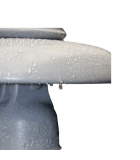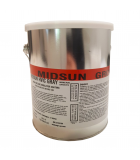Anti-arcing coating

Insulators with rough and dirty surfaces provide an ideal base ofr the accumulation of airborne pollutants. In dry conditions, these deposits reduce insulating performance. In humid conditions, under the effects of condensation or when wet, a thin film of water can form, encouraging the crystallisation of salts. When there is a high concentration of salts combined with conductive solid particles, these deposits can have severe consequences for the integrity and performance of the insulators.
MIDSUN® HVIC: unrivalled protection against electric arcs flash
The HVIC silicone coating is a special hydrophobic coat that extends the life of your insulators and increases their reliability at a lower cost. Its unique formula allows, once the HVIC coat is applied, to reduce fouling and deposits on your porcelain or glass insulators. Due to its self-cleaning composition, HVIC prevents excessive leakage currents, discharge elongation and arcing, minimising the need for periodic maintenance, cleaning or greasing of insulators.
SAKAPHEN SAEKA SÄKA: effective and long-lasting protection for HV insulators
The SÄKA 80 cleaning paste and SÄKA 81 silicone grease are designed to provide optimal protection for insulators, especially in humid or heavily polluted environments. The cleaning paste forms a protective silicone layer, preventing the adhesion of dust and granular materials while guarding against electrical arcs. The silicone grease offers hydrophobic protection, abrasion resistance, and prevents the formation of water films and dust deposits, ensuring superior protection against electrical arcs and irreversible damage.
Subcategories
-

HVIC
HVIC silicone coating for high electric arc protection, that extends insulator life and increases reliability at lower cost.
It offers a long-term solution to breakdown problems. It is particularly used on insulators in dirty areas, such as cement plants, steel mills, seafronts exposed to salt spray, areas subject to sand, dust or organic plant or animal deposits.




